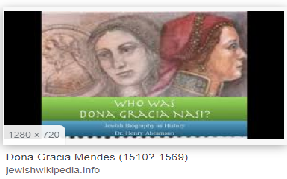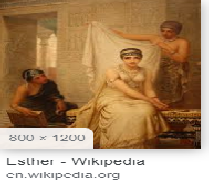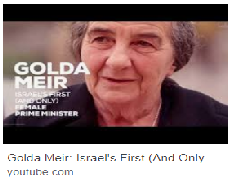|
PART 1 T O P I C |
|
|
|
|
|
|
|
|
|
|
|
|
|
|
|
|
|
|
JewishWikipedia.info
THE
INCREDIBLE
STORY OF THE JEWISH PEOPLE
THE JEWISH WOMAN IN MEDIEVAL IBERIA



EDITORS NOTE
This is an extract from which illustrates the central role the Jewish woman played at the time of the Expulsion From Spain in 1492
Go to Dona Gracia Nasi one of the greatest women in Jewish history
It is taken from
THE JEWISH WOMAN IN MEDIEVAL IBERIA
Renée Levine Melammed
Academia, March 2020
From p253 on (this is the starting page of this paper)
Assessing the lives of Jewish women in medieval Iberian culture is not an easy task, and there is no doubt about the fact that their experiences were not identical to those of the men. Iberian Jewish men were poets, merchants, rabbis, physicians, courtiers and tax farmers, but what were their wives and mothers and daughters doing? Few images come to mind when one considers the Iberian Jewish woman, leaving one to wonder how she experienced the Golden Age of poetry and philosophy, the Reconquista, the riots of 1391, the Inquisition, and the Expulsion. While the existing evidence does not provide a complete picture of women’s lives, one does discover many independent, savvy, strong and determined women. Some defied their husbands as well as both Christian and Jewish authorities. Others relied upon Jewish law in order to validate their independent lifestyle, while yet others turned to non-Jewish authorities in their quest for justice. Outstanding among them were widows, married women whose husbands blatantly ignored clauses in marital contracts, and judeo-conversas. Only by examining some of these lives can one gain a better understanding of the world of the medieval Iberian Jews, regardless of their gender. While Jews were already residing in Iberia prior to the Visigothic invasion in the fifth century, next to nothing is known about their lives at that time except what is revealed in a series of rules concerning forced conversions and reversions to Judaism; womenare only mentioned tangentially. Prohibitions and punishments were not identical for men and women and the latter are scarcely mentioned in the vast lists of anti-Jewish laws. When the peninsula was later conquered by the Muslims in 711, the lives of Jews were altered, but any immediate repercussions of this transfer of power for women remain a mystery. Islamic rule led to urbanization, to demographic explosion, and enabled the hegemony of the Babylonian Talmud among Andalusi Jews, but there are no records as to how these developments might have affected women’s lives. No doubt the lingua franca for all of the Jewish communities gradually became Arabic, but determining the influence of this new cultural and religious milieu on women in particular is next to impossible. For example, it cannot be ascertained if, when or where Jewish women wore veils; it is also a challenge to attempt to assess to what degree the Islamic practice of polygamy affected Jewish women’s lives.
Jewish men could more easily take advantage of the opportunity to immerse themselves in the cultural world of the Arabs as it developed in Spain and were able to acquire proficiency in linguistics, grammar, philosophy, philology, astronomy and medicine. The creation of the cultural hub of Córdoba under Umayyad rule (756-1008) resulted in a parallel development, albeit on a more modest level, within the male Jewish world. The resulting creativity on the part of the men,who viewed themselves as the spiritual heirs of the Bible, the Talmud and religious poetry, has been categorized as a golden age, but the role of women during this period is rarely discussed
From p260 on
PARTICIPATION IN THE PUBLIC SPHERE AND INHERITANCES
Women have always engaged in work, both in the domestic and public realms. Jewish men did not encourage the presence of women outside the home, yet there were always independent women whodid not conform to societal expectations. The documentation concerning women’s activities in the medieval Mediterranean society of the Cairo Geniza makes it clear that although they were living under the rule of Islam, women of all classes were working. Although some modern scholars claim that it may have been difficult for Jewish and Muslim males in Spain “to see women active in public as merchants and property owners,” one can assume that women whose husbands had died or were absent from home, or who had their own assets, were nonetheless to be found working outside the home. In Christian society as well, when the head of the family was away, he was replaced by his wife; some of these husbands might have held public or military roles, which meant that as a result, the women were left to manage the family property, businesses and estates.
More material becomes available concerning women’s economic activities during the period of Christian hegemony in the Peninsula(1100-1500). The changes that occurred during the early years of the Reconquista appear to have granted greater opportunities to Jewish women as well as to Jewish men. Jewish women were moneylenders,owned property, were involved in trade, handicrafts, spinning,weaving, leather crafting, selling shoes, furs, and foodstuffs, and manufacturing. In Castilian towns seeking to foster local commercial enterprise, religious minorities and women could be found owning shops or stalls in the market and working as peddlers.
Hebrew as well as Latin documents from Perpignan revealthat in the second-largest Jewish community in the thirteenth-century Crown of Aragon, Jews of both sexes were engaged inmoney lending. The most active women were widows, but wives were involved as well, sometimes as the result of financial stress or bankruptcy or when there were no males available to run the family business. Many had their own lending concerns: between 1261 and 1286, there are records of twenty-five money-lending activities by women, fifteen of whom were widows. While women’s loans tended to be more modest than those of their male counterparts (and were often granted by women to women), the wealthier women were dealing with loans of substantial sums. Many widows were named as guardians in order to administer their children’s finances, and thus experienced a measure of both legal and economic power. As a result, widows, whether Jewish or Christian, were not inclined to remarry, because it would entail surrendering their economic independence. Many of them had been granted guardianship or co-guardianship of their husband’s property and of their children. Consequently, remarriage entailed a serious regression in terms of their newly acquired status and was clearly viewed by them as undesirable; essentially it meant a loss of custody of the children as well as a loss of status in the community. Interestingly enough, Jewish law also made remarriage somewhat undesirable. As long as the widow elected to remain single or did not claim her marriage contract (ketubbah), she was clearly entitled to support, and this too served as an incentive not to remarry. Her heirs could not easily force her to act against her will, and thus the advantages of not remarrying spoke for themselves.
From p274 on
Leonor of Atienza served as a wet nurse, clearly replacing aJewish mother in her maternal role, and Francisca of Berlanga alsoconfessed in 1504 to serving as a wet nurse. Sanchos wife María ofAtienza confessed to entering a synagogue one day and lighting thelamp there as instructed by the Jews; she also ate matzoh and drankkosher wine. These conversas were sharing food, drink and lifeevents with Jews as well as helping them as wet nurses or by lightingfires for them on the Sabbath in their homes and synagogues.
Elsewhere, María López of Berlanga was paying a Jew on Fridayafternoons to prepare Sabbath stews for her. In 1492, Isabel ofCuenca referred to her “friend the Jewess” who sent her a special stew on the Sabbath. She, in turn, sent her servant to help her friend on the Sabbath; the servant was the Sabbath gentile in this case and not the conversa, whose husband was unaware of her activities.
Likewise did Juana Sánchez engage in clandestine contact with Jews.This storekeeper sold fish and oil to a Jewish woman, sometimes giving her extra oil for lighting the synagogue lamps. When Juana’s husband Alonso discovered what she had been doing, he became infuriated, so she simply proceeded to conceal future activities from him. In addition, she gave wax candles to a Jewish relative for use in the Sigüenza synagogue, again hiding her actions from her husband. When she fasted on Yom Kippur and her husband learned about it, he once again became extremely angry. It seems that her aforementioned Jewish relative was not well off, for she provided her with a skirt, headdresses and other clothes, as well as wheat.
Again, there is ample evidence that the women were supporting one another, regardless of the fact that they now technically belonged to
275
two different religious groups. Their familial and social ties had not been broken; they celebrated together, aided one another when in distress, and supported one another.
Although some of these documents were recorded after the Expulsion, they clearly refer to pre-1492 activities that occurred while Jewish women were still residing on the Peninsula. Needless to say, life changed for the conversos as well as for the Jews in 1492.The Inquisition and the Crown assumed that the Judaizing heresy would slowly but surely be extirpated, but did not take into account that the Expulsion was essentially creating a new group of conversos and conversas. The conversions that took place during the spring and summer of 1492 were technically voluntary, but not because these Jews had “seen the light”; those who could not bear to leave their homes were not exactly anxious to become Catholics. The Inquisition learned that it now had to confront this new generation of New Christians who were Judaizing. Post-1492 conversa activity is characterized by the messianic movement led by twelve-year-old Inés of Herrera at the turn of the century, a movement that attracted numerous followers and quickly spread throughout Extremadura.The large number of older women who had converted in 1492 who joined this movement, only to face trials and certain death, speaks for itself. These women were anxious to return to their ancestral religion, for their conversions had been half-hearted.
Attempting to assess the means by which Hispano-Jewish women dealt with this trauma is no easy task. There are, however, a few clues as to their mindset that point to their preference to emigrate rather than convert. As one historian has noted, “Conversion implied a far more violent break with the past and presented difficulties of adjustment and adaptation more daunting than those faced by their husbands.” One Jew from Huesca left Aragon with his family because his mother insisted upon it, only to return later with his wife and children once his mother had passed away. Among the heads of family who opted to go north to the small Iberian kingdom of Navarre in 1492, some were hoping that they would eventually succeed in convincing their wives to convert to Catholicism. One of them told an official that he expected to be converting along with his family, if not now, then later. Women seemed far more reluctant to convert than men. Some men converted without their wives, while others objected to their wives’ reluctance to abandon Judaism. Even after the Expulsion, petitions were being presented to the Crown for permission to return by men whose wives had prevented them from converting or had caused the couples to part ways.
The world of Spanish Jewish women was constantly changing,for it reflected their experiences in and with the surrounding society. While tied to their roles as mothers and wives, they were subject to the influences and mores of the ruling religions. These women manoeuvred to the best of their abilities, often taking advantage of the offerings and developments around them. A few entered the world of patronage and poetry; others were active in the economic realm.Some crossed religious and sexual borders and others contended with rabbinic rulings within their own communities. The women in medieval Iberia dealt with the influences of two religions, some ofwhich offered them new options and some of which complicated their lives. In the long run, they were not left with many choices:to convert or to abandon their homeland but not their religion.Those conversas who were steadfast in their ties to Judaism were joined by a new wave of converts in 1492. At the same time, many Jewish women chose not to convert but rather to leave the world that had been part and parcel of the lives of their ancestors from time immemorial.
|
Jewish Women |
